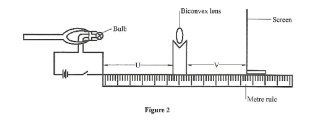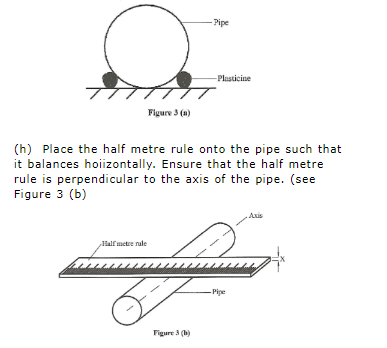
Kenya Certificate of Secondary Education
Practical
2020 Physics paper 3
Question 1
You are provided with the following:
- Two cells in a cell holder;
- A switch;
- A micrometer screw gauge;
- A nichrome wire mounted on a millimetre scale;
- A voltmeter;
- An ammeter;
- A jockey:
- Connecting wires with crocodile clips.Proceed as follows:
Using the micrometer screw gauge, measure and record the diameter d of the wire.
d=……..mm
d=………m (1 mark)
Set up the apparatus as shown in Figure 1.

Using the voltmeter, measure the potential difference E across the battery before closing the switch.
E = ……..volts. (1 mark)
Adjust the length L of the wire to 0.1m (10cm). Close the switch, read and record the value of the current I in Table 1.
Repeat (d) for the other values of L given in Table 1. Complete the table. (6 marks)
| Length L (m) | 0.1 | 0.2 | 0.3 | 0.4 | 0.5 | 0.6 | 0.7 |
|---|---|---|---|---|---|---|---|
| Current I (A) | |||||||
| Current I (A) |
On the grid provided; plot the graph of 1/I (y axis) against L. (5 marks)

- From the graph, determine the:
(i) Gradient S; (3 marks)
(ii) Intercept C on the 1/I axis. (1 mark)
h. Given that:
(i) 4K1/πd²E = S determine the value of K1
(ii) K1/E = C determine the value of K2
Question 2
You are provided with the following:
- A metre rule;
- A biconvex lens;
- Source of light (bulb in a bulb holder, cells in a cell holder and a switch);
- A stand boss and clamp;
- A lens holder;
- A screen;
- A half metre rule;
- Three pieces of plastic pipes A, B and C;
- A vernier callipers (to be shared);
- A stopwatch;
- Some plasticine.Proceed as follows PART A
(a) Clamp the bulb holder onto the stand. Arrange the bulb, the lens and the screen along the metre rule as shown in Figure 2.

(b) Adjust the distance of the bulb from the lens to U = 25 cm. Put on the switch and adjust the position of the screen from the lens so that a sharp image of the bulb is observed.
Record the distance V between the screen and the lens in Table 2.
(c) Repeat part (b) for the other values of U shown in Table 2. Complete the table. (7 marks)
| U cm | 25 | 30 | 35 |
|---|---|---|---|
| V cm | |||
| M = V/U | |||
| F=V/M+1 |
(d) Determine the average value of F.(2 Marks)
PART B (e) Using the vernier callipers measure and record the diameters of the three pipes.
dA, dB and dC
dA= ……….Cm……………… m
dB= ……….Cm……………… m
dC= ……….Cm……………… m
(f) Measure and record the thickness X of the half metre rule.
X= ………………..CM……………… m
(g) Place the pipe marked A on the bench and use the plasticine to stop it from rolling. (see Figure 3 (a)

(i) Push one end of the balanced half metre rule slightly downwards and release it so that it oscillates up and down. Measure and record in Table 3 the time for five complete oscillations.
(j) Repeat the procedure in (g), (h) and (i) for the other‘ pipes B and C. Complete Table 3.(5 marks)
| Pipe A | Pipe B | Pipe C | |
|---|---|---|---|
| Diameter d (m) | |||
| Time for five oscillations Periodic time T (s) | |||
| Periodic Time T(S) | |||
| Ƶ= T√3(d – X)/2 |
(k) Determine the average value of Z (2 marks)
